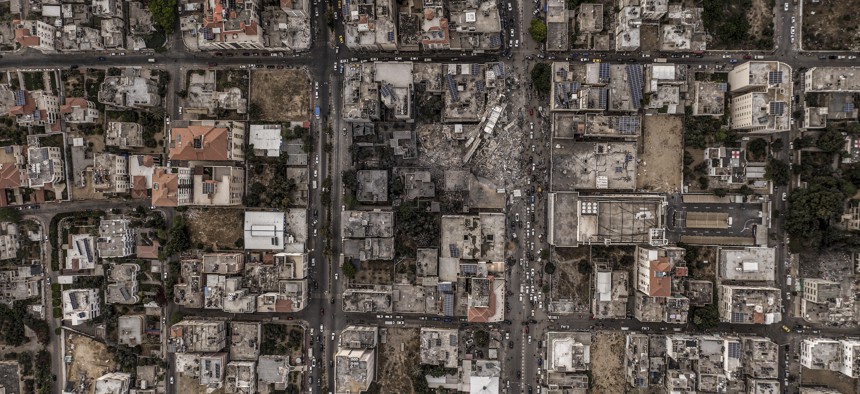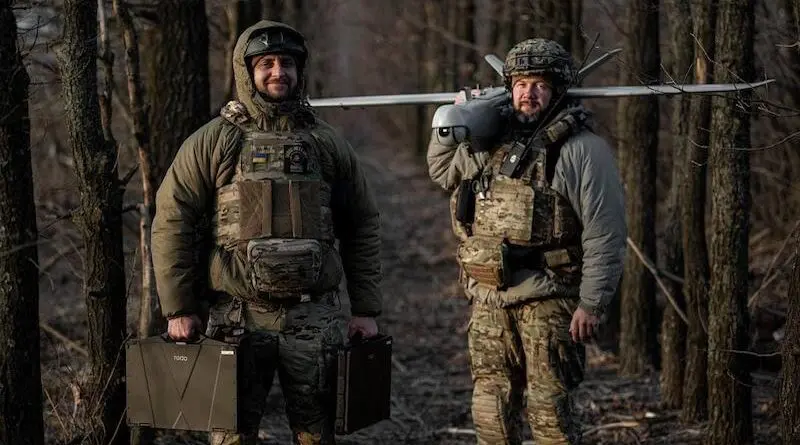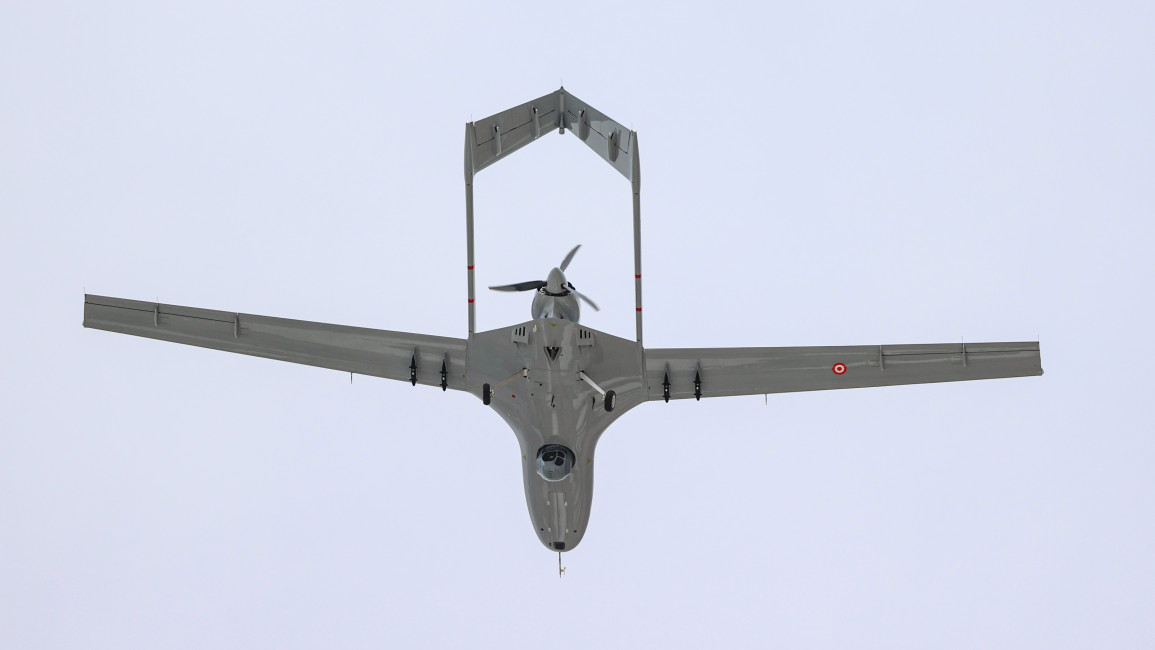It’s time global leaders set new rules for these future weapons already being using to kill.

A drone views of the ruins of buildings in Gaza city that was levelled by an Israeli air strike during the recent military conflict between Israel and Palestinian ruled by Hamas on June 11, 2021.
BY ZAK KALLENBORN
JULY 7, 2021
DEFENSEONE.COM
In a world first, Israel used a true drone swarm in combat during the conflict in May with Hamas in Gaza. It was a significant new benchmark in drone technology, and it should be a wakeup call for the United States and its allies to mitigate the risk these weapons create for national defense and global stability.
Israel’s use of them is just the beginning. Reporting does not suggest the Israeli Defense Forces deployed any particularly sophisticated capability. It seems a small number of drones manufactured by Elbit Systems coordinated searches, but they were used in coordination with mortars and ground-based missiles to strike “dozens” of targets miles away from the border, reportedly. The drones helped expose enemy hiding spots, relayed information back to an app, which processed the data along with other intelligence information. Future swarms will not be so simple.
Often the phrase “drone swarm” means multiple drones being used at once. But in a true drone swarm, the drones communicate and collaborate, making collective decisions about where to go and what to do. In a militarized drone swarm, instead of 10 or 100 distinct drones, the swarm forms a single, integrated weapon system guided by some form of artificial intelligence.
So, drone swarms are here, and we should be worried. But how best to reduce the risk these weapons pose?
The United States should lead the global community in a new conversation to discuss and debate whether new norms or international treaties are needed specifically to govern and limit the use of drone swarms. Current proposals to ban autonomous weapons outright would cover autonomous drone swarms; however, such a treaty would not likely cover the drone swarm Israel used. Despite some media reports to the contrary, there is no indication the swarm made autonomous decisions on who to kill (whether a small, human-controlled swarm like this should be banned is a different issue). And it’s unlikely the great powers will agree to a broad prohibition autonomous weapons. Narrow restrictions on high-risk autonomous weapons like anti-personnel drone swarms may have more appeal, particularly if they create asymmetric effects that threaten, but not help, great powers.
Related articles
The Pentagon Wants AI-Driven Drone Swarms for Search and Rescue Ops
The U.S. Military’s Drone Swarm Strategy Just Passed a Key Test
Pentagon Wants More Money for Lasers To Defend Against Missiles, Drone Swarms
Global militaries should expand work to develop, test, and share counter-swarm technology. Effective counter-drone systems need to be low cost, quick recharging, and able to hit multiple targets at once. Such systems should be deployed around high-risk target areas, like airports, critical infrastructure, and heads of state. As the threat is fundamentally international, states should also provide their cutting-edge counter-swarm capabilities to partners and allies who are at risk.
Keeping drone swarms from the hands of terrorists will require a separate effort. States may adopt measures akin to United Nations Security Council Resolution 1540 on preventing terrorist acquisition of chemical, biological, radiological, and nuclear weapons that apply to drone swarms (or just expand UNSCR 1540). Local, national, and international law enforcement agencies should also search for indicators of terrorists seeking drone swarm capabilities, such as large drone purchases and known extremist work to develop or modify drone control systems.
In recent years, the threat of drone swarms has grown alongside their increasing sophistication. In 2016, the Department of Defense launched 103 Perdix drones out of three F/A-18 Super Hornets. The drones operated using a “collective brain,” gathering into various formations, flying across a test battlefield, and reforming into new configurations. Notably, the system was designed by students at the Massachusetts Institute of Technology. If drone swarms are simple enough students can make them, conflict zones across the world can expect to see them soon. In the past year, China, France, India, Spain, South Africa, the United States, and the United Kingdom have all unveiled or tested new drone swarm programs.
Global proliferation of drone swarms creates risks of instability. In the Nagorno-Karabakh conflict last year, Azeri use of drones contributed significantly to a rapid Armenian surrender (other factors no doubt helped too). A swarm amplifies such effects with more drones, using more complex tactics that can overwhelm existing defenses. It’s a concern the U.S. military has studied for a decade already. A 2012 study by the Naval Postgraduate School simulated eight drones attacking a U.S. Navy destroyer, finding four drones would hit the ship. Terrorists may also see great appeal in drone swarms as a more accessible air force to overcome ground-based defenses, and carry out attacks on critical infrastructure and VIPs.
Drone swarms create risks akin to traditional weapons of mass destruction. As drone swarms scale into super-swarms of 1,000 or even up to a million drones, no human could plausibly have meaningful control. That’s a problem, autonomous weapons can only make limited judgments on the civilian or military nature of their targets. The difference of a single pixel can change a stealth bomber into a dog. Errors may mean dead civilians or friendly soldiers, and accidental conflict escalation.
The reality is that virtually no current counter-drone systems are designed for counter-swarm operations. Current detections systems cannot necessarily accommodate multiple drones. They could overwhelm interdiction systems, which contain limited or slow-to-shoot interceptors. And the drone swarm may simply be too spread out. Of course, new counter-drone systems like the Air Force’s microwave-based THOR system, low cost per shot defenses like lasers, and counter-swarm swarms may eventually prove effective. While these defenses may protect great powers, smaller states and civilians are likely to be more vulnerable.
The increased autonomy of a drone swarm allows states to use many more drones at once. Human cognition limits simultaneous drone operation, because it is difficult to monitor operations of many drones, ensure they do not collide, and still achieve mission objectives. But the military is working to overcome human limitations. In one 2008 study, a single operator could handle only four drones without significant losses to mission effectiveness. By 2018, the U.S. military’s Defense Advanced Research Projects Agency, or DARPA, confirmed a human could control an entire drone swarm telepathically, using a single microchip implanted in their brain.
The military value of drone swarms stems from enabling complexity and flexibility. Current swarms use typically small, homogenous drones. Future swarms may be of different sizes, equipped with an array of different interchangeable sensors, weapons, and other payloads. That enables combined armed tactics, where drones strike with multiple weapons from multiple angles: one may spray bullets, while another sprays a chemical weapons agent. Swarms may also have adaptive properties such as self-healing, where the swarm modifies itself to accommodate the loss of some members, or self-destruction, to complete one-way missions. Drone swarms will also likely be increasingly integrated into some form of drone mothership (and perhaps integrated into an even larger mothership in a “turducken of lethality.”)
Drone swarms are not science fiction. The technology is here, and spreading fast.
Zachary Kallenborn is a national / homeland security consultant, specializing in unmanned systems, drone swarms, homeland security, weapons of mass destruction (WMD), and WMD terrorism.








